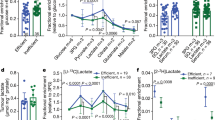Abstract
The activity of diamine oxidase (DO, EC 1.4.3.6.) which converts putrescine into gamma-aminobutyraldehyde in the degradative pathway of polyamine, was studied in 4 human melanoma cell lines, 2 of which produce tumours in greater than 80% of nude mice (M3Dau, M4Beu), whereas the other 2 induce tumours in less than 25% (M1Dor, M2GeB). The activity of DO in these cells varies with the growth rate: 24 h after seeding there is an initial increase in DO activity, followed by a steep decline during exponential growth. At 96 h, when cells reach saturation density, the activity of DO is significantly greater in the highly tumorigenic cell lines than in the poorly tumorigenic cell lines. Kinetic studies show that for the highly tumorigenic lines apparent Km values are 10.6 X 10(-6)M +/- 0.2 (M3Dau) and 14.2 X 10(-6) M +/- 0.6 (M4Beu), whereas for the poorly tumorigenic lines the values are 4.5 X 10(-6) M +/- 0.3. After transplantation into nude mice, the M1Dor cell line, which exhibits a low Km (app.) for DO of which had high Km (app.) value. Km (app.) determination of DO could be an approach for characterizing human melanoma cells differing in their tumorigenic potential in nude mice.
Similar content being viewed by others
Rights and permissions
About this article
Cite this article
Thomasset, N., Quash, G. & Doré, J. Diamine oxidase activity in human melanoma cell lines with different tumorigenicity in nude mice. Br J Cancer 46, 58–66 (1982). https://doi.org/10.1038/bjc.1982.165
Issue Date:
DOI: https://doi.org/10.1038/bjc.1982.165
- Springer Nature Limited
This article is cited by
-
Subcutaneous injection of multipotent mesenchymal stromal cells admixed with melanoma cells in mice favors tumor incidence and growth: a systematic review and meta-analysis
Archives of Dermatological Research (2018)
-
Rapid characterization and partial purification of various animal amine oxidases
Experientia (1984)




